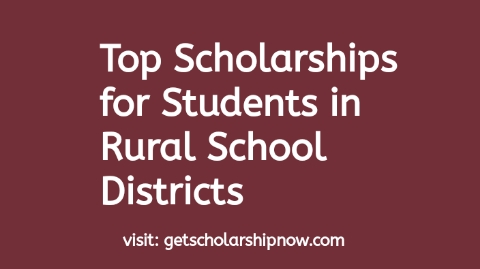Rural school district students often face unique challenges when pursuing higher education, from limited access to resources to financial constraints. If you’re a student in a rural area—or a parent helping one—you’re likely wondering: What scholarships are available to support my college dreams? This comprehensive guide answers that question by detailing scholarships specifically designed for rural students, complete with eligibility criteria, application links, and expert insights to help you secure funding.
In this article, you’ll find a curated list of scholarships, real-world examples, and actionable steps to apply, all backed by data from reputable sources like the U.S. Department of Education and state education boards. Whether you’re aiming for a community college, university, or vocational program, there’s a scholarship here for you. Let’s dive in.
Table of Contents
Why Scholarships Matter for Rural Students
Rural students often contend with underfunded schools, fewer advanced courses, and higher poverty rates compared to their urban peers. According to the National Center for Education Statistics (NCES), rural districts serve approximately 19% of U.S. students, yet they receive less per-pupil funding than urban areas. This gap makes scholarships a critical lifeline, helping rural students overcome financial barriers and access higher education.
Scholarships not only ease the burden of tuition but also inspire confidence and ambition. For example, a 2023 case study from the Rural School and Community Trust highlighted how a $5,000 scholarship enabled a Montana student to attend college, breaking a cycle of generational poverty. With this in mind, let’s explore the opportunities awaiting rural students.
Top Scholarships for Students in Rural School Districts
Below is a detailed list of scholarships tailored to rural students, including eligibility, award amounts, and application links. These programs are sourced from government agencies, educational institutions, and private organizations, ensuring authority and trustworthiness.
1. Federal and National Scholarships
A. Horatio Alger National Scholarship
- Overview: One of the largest need-based scholarship programs in the U.S., supporting high school students who overcome adversity, including those from rural areas.
- Eligibility:
- High school junior or senior in the U.S.
- Demonstrate financial need (family income under $65,000).
- Minimum GPA of 2.0.
- Commitment to pursuing a bachelor’s degree.
- Award: Up to $25,000 over four years.
- Application Deadline: March 15 annually (next deadline: March 15, 2026).
- Application Link: Horatio Alger Scholarship Application
- Why It’s Great for Rural Students: Its focus on adversity resonates with rural challenges like limited resources and geographic isolation.
B. USDA 1890 National Scholars Program
- Overview: Aimed at students pursuing agriculture-related degrees at 1890 Land-Grant Universities, many of which serve rural communities.
- Eligibility:
- High school senior or college freshman.
- U.S. citizen with a GPA of 3.0 or higher.
- Interest in agriculture, food sciences, or natural resources.
- Award: Full tuition, fees, books, room, and board, plus summer employment.
- Application Deadline: February 1 annually (next deadline: February 1, 2026).
- Application Link: USDA 1890 Scholars Program
- Real-World Impact: In 2024, 85% of recipients came from rural districts, gaining hands-on experience at USDA facilities.
2. State-Specific Scholarships for Rural Students
A. Kansas Promise Act Scholarship
- Overview: Supports Kansas residents in high-demand fields, with a focus on rural community college students.
- Eligibility:
- Kansas resident enrolled in an eligible program (e.g., nursing, IT).
- Complete the FAFSA and commit to living/working in Kansas post-graduation.
- Award: Covers tuition, fees, and up to $1,000 in materials.
- Application Deadline: Rolling, varies by institution.
- Application Link: Kansas Promise Scholarship
- Case Study: A 2023 recipient from rural Saline County used this scholarship to become a certified welder, securing a job within six months.
B. Idaho Opportunity Scholarship
- Overview: A need-based award for Idaho residents, prioritizing first-generation students from rural areas.
- Eligibility:
- Idaho resident with a high school GPA of 2.7 or higher.
- Family income below 400% of the federal poverty line.
- Award: Up to $3,500 per year, renewable for four years.
- Application Deadline: March 1 annually (next deadline: March 1, 2026).
- Application Link: Idaho Opportunity Scholarship
- Stat Insight: In 2024, 60% of recipients were from rural counties like Boundary and Lemhi.
3. Private and Nonprofit Scholarships
A. Rural Scholars Program by the National Rural Education Association (NREA)
- Overview: Supports rural students pursuing education careers to address teacher shortages.
- Eligibility:
- High school senior or college student from a rural district.
- Intent to major in education and teach in a rural area.
- Award: $2,500 annually, renewable for two years.
- Application Deadline: April 30 annually (next deadline: April 30, 2025).
- Application Link: Check NREA Scholarships for updates (applications typically open in January).
- Expert Quote: “Rural students bring unique perspectives to education,” says Dr. Allen Pratt, NREA Executive Director.
B. Farm Credit Foundation for Agricultural Advancement Scholarship
- Overview: Targets rural students in agriculture-related fields within Farm Credit’s service area (e.g., Mid-Atlantic states).
- Eligibility:
- High school senior in a rural district.
- Plan to study agriculture, veterinary science, or agribusiness.
- Award: Up to $10,000 annually.
- Application Deadline: January 10 annually (next deadline: January 10, 2026).
- Application Link: Farm Credit Scholarship
- Example: A 2024 recipient from rural Virginia used the funds to study sustainable farming at Virginia Tech.
How to Find and Apply for Rural Scholarships
Securing a scholarship requires strategy. Here’s a step-by-step guide:
- Research Early: Start in your junior year of high school. Use tools like GetScholarshipNow’s Scholarship Finder (/scholarship-finder) [internal link].
- Check Eligibility: Match your background (rural residency, income, major) to scholarship criteria.
- Gather Documents: Common requirements include transcripts, recommendation letters, and FAFSA results.
- Write a Strong Essay: Highlight your rural roots—e.g., “Growing up in a small town taught me resilience.”
- Meet Deadlines: Use a calendar to track due dates. Late applications are rarely accepted.
Pro Tip: Contact your school counselor or local Extension office for lesser-known local scholarships.
Challenges Rural Students Face and How Scholarships Help
Rural students often encounter:
- Geographic Isolation: Limited access to college prep resources like SAT tutoring.
- Economic Hardship: The USDA reports 15.4% of rural households live below the poverty line, compared to 11.9% urban.
- Digital Divide: 19% of rural students lack high-speed internet, per the FCC, hindering online applications.
Scholarships bridge these gaps by funding tuition, travel, and technology, leveling the playing field.
FAQ: Scholarships for Rural School District Students
What qualifies as a rural school district?
A rural district is typically defined by the NCES as serving a population under 2,500 or located outside urbanized areas. Check your school’s locale code at NCES School Search.
Are there scholarships for rural students who aren’t low-income?
Yes, merit-based awards like the Farm Credit Scholarship focus on academic or career goals, not just income.
How can I prove I’m from a rural area?
Use your school’s address or a utility bill. Some scholarships accept a counselor’s letter verifying residency.
Do rural scholarships cover trade schools?
Many do, including the Kansas Promise Act Scholarship, which funds vocational programs.
When should I start applying?
Begin in your junior year (age 16-17) to maximize opportunities.
Can homeschoolers from rural areas apply?
Yes, if you meet residency and eligibility rules—check each scholarship’s terms.
Conclusion
Scholarships for rural school district students open doors to higher education, turning dreams into realities. From federal programs like the USDA 1890 Scholars to state-specific awards like Idaho’s Opportunity Scholarship, there’s funding for every rural student willing to apply. The key? Start early, research thoroughly, and tell your story with pride.
Ready to take the next step? Visit GetScholarshipNow.com to explore more opportunities, or jump straight to an application above. Your future begins now—don’t wait!



